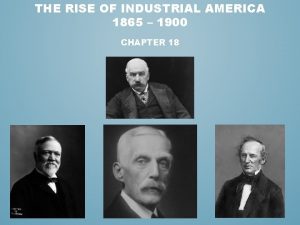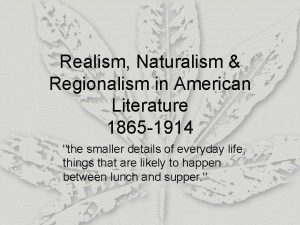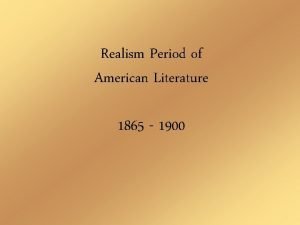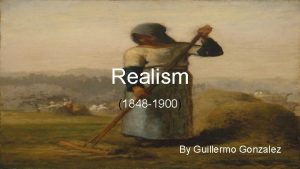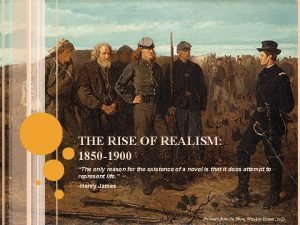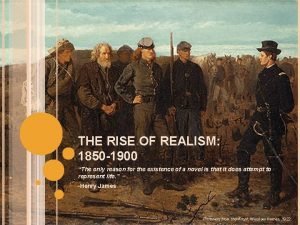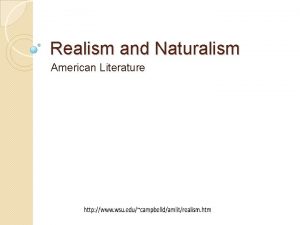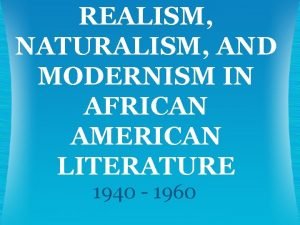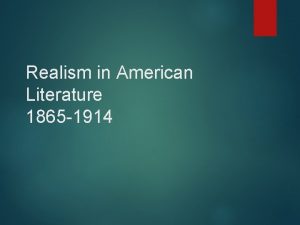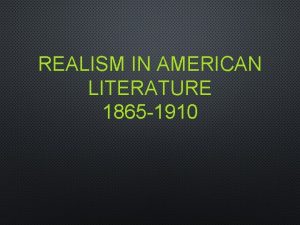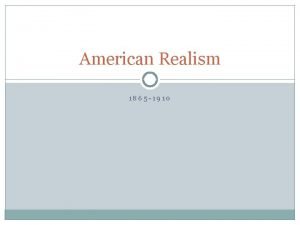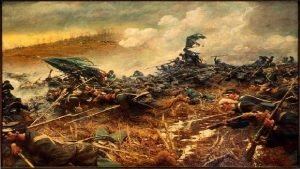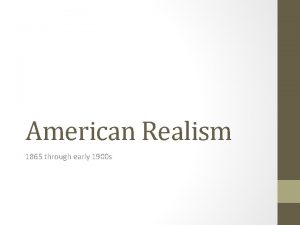Realism Period of American Literature 1865 1900 CHARACTERISTICS










- Slides: 10

Realism Period of American Literature 1865 - 1900

CHARACTERISTICS of REALISM Life presented with fidelity in presenting the inner workings of the mind. There is an analysis of thought and feelings in realism. The environment has a function in shaping of characters. The setting is generally in the present or recent past. There is frequent use of colloquial speech. Diction is natural vernacular, not heightened or poetic; tone may be comic, satiric, or matter-of-fact. Characters are of the middle and low classes.

Realist writers exposed political corruption, economic inequity, business deception, the exploitation of labor, women rights problems, racial inequity Realist often describe the relationship between the economic transformation of America and its moral condition. We see in realism the introduction of a new kind of characters: · Industrial workers and rural poor · Ambitious businessman and vagrants · Prostitutes · Unheroic soldiers

REGIONAL WRITING (Local Color) There is a desire by Realist writers to preserve distinctive ways of life before industrialization dispersed or homogenized them. Realist writers wrote about coming to terms with the harsh realities of the “new times. ” The rapid growth of magazines creating a new, largely female audience for short fiction. Many Local Colorists (realistic female writers) described a patriarchal society from female perspective.

Definition of Realism is the post civil war literary movement between 1865 -1900. Realism directly opposes the previous movement Romanticism. It focuses on the harsh realities of life and gives the reader a true sense of “local color”. Which is the fictional recreation of the authors own experiences. Realism renders reality closely and in comprehensive detail. Selective presentation of reality with an emphasis on verisimilitude, Character is more important than action and plot; and complex ethical choices are often the subject.

Realist Writers Mark Twain (1835– 1910) Henry James (1843 – 1916) William Dean Howells (1837 – 1920) “Local Color” Sarah Orne Jewett (1849 – 1909) Kate Chopin (1851 – 1904) Bret Harte (1836 – 1902) Charlotte Perkins Gilman (1860 – 1935) Poetry: Edward Arlington Robinson (1869 – 1935) Robert Frost (1874 – 1963) Carl Sandburg (1878 – 1967)

The Realism Period (1865 -1900) Incorporates a difficult time in American history, with the Civil War, industrialization, Reconstruction, urbanization, and more. In American literature, famous writers like Charles W. Chesnutt, Stephen Crane, Henry James, Mark Twain, and Edith Wharton were presenting a more realistic view of life in their works of literature.

In American literature, the term "realism" encompasses the period of time from the Civil War to the turn of the century during which William Dean Howells, Rebecca Harding Davis, Henry James, Mark Twain, and others wrote fiction devoted to accurate representation and an exploration of American lives in various contexts. As the United States grew rapidly after the Civil War, the increasing rates of democracy and literacy, the rapid growth in industrialism and urbanization, an expanding population base due to immigration, and a relative rise in middle-class affluence provided a fertile literary environment for readers interested in understanding these rapid shifts in culture. In drawing attention to this connection.

Broadly defined as "the faithful representation of reality" or "verisimilitude, " realism is a literary technique practiced by many schools of writing. Realism is a technique that denotes a particular kind of subject matter, especially the representation of middle-class life. There is a revolt against romanticism, an interest in scientific method, the systematizing of the study of documentary history, and the influence of rational philosophy, all affected the rise of realism.

Realism is nothing more and nothing less than the truthful treatment of material. William Dean Howells
 The rise of industrial america 1865-1900
The rise of industrial america 1865-1900 The rise of industrial america 1865-1900
The rise of industrial america 1865-1900 1865 to 1900 inventions
1865 to 1900 inventions Regionalism literary movement
Regionalism literary movement Characteristics of realism literature
Characteristics of realism literature Realism (1848–1900)
Realism (1848–1900) Realism 1850
Realism 1850 Realism 1850 to 1900
Realism 1850 to 1900 Realism in american literature
Realism in american literature Naturalism in literature definition
Naturalism in literature definition Realism naturalism modernism
Realism naturalism modernism

